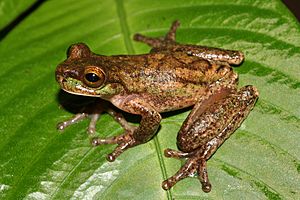Isthmohyla rivularis facts for kids
Quick facts for kids Isthmohyla rivularis |
|
|---|---|
 |
|
| Conservation status | |
| Scientific classification | |
| Synonyms | |
|
Hyla rivularis Taylor, 1952 |
The Isthmohyla rivularis is a very rare type of frog. It belongs to the family Hylidae, which includes many tree frogs. This special frog lives in the mountains of Costa Rica and nearby western Panama.
For a while, people thought this frog had completely disappeared. But in 2007, scientists were excited to find one male frog again in the Monteverde Cloud Forest in Costa Rica. Then, in 2008, they found a female frog ready to lay eggs and a few more males! This frog is sometimes called the American Cinchona Plantation treefrog.
Contents
What Does the Isthmohyla rivularis Look Like?
Male Isthmohyla rivularis frogs can grow to about 3.4 centimeters (1.3 inches) long. Females are a bit bigger, reaching about 3.7 centimeters (1.5 inches) long. Their snout, which is the front part of their head, is quite short and rounded.
This frog's ears, called the tympanum, are hard to see. Its fingers have large, round pads at the tips. These pads help the frog grip surfaces. Its fingers are also partly webbed, meaning there's skin between them. The toes have pads too, but they are slightly smaller than the finger pads. The toes are about two-thirds webbed.
The color of the frog's back can be grey or light brown. Many of these frogs have a thin, dark line that goes through their eye. They might also have other dark spots or marks. The sides of their body are usually yellowish. Sometimes, they can even look greenish or bluish. The frog's eye color is bronze with black patterns.
Where Does the Isthmohyla rivularis Live?
The Isthmohyla rivularis frog lives near or in clear streams. These streams are found in rainforests that are either lower down or in the mountains. They live at heights between 1,210 to 2,040 meters (about 3,970 to 6,690 feet) above sea level.
Male frogs like to call out from plants that are near or hanging over fast-moving streams. This is how they attract mates. The baby frogs, called tadpoles, grow and develop in these same streams.
Why Is This Frog in Danger?
This frog used to be common in some areas where it lived. But its numbers have dropped a lot. Scientists believe a big reason for this decline is a disease called chytridiomycosis. This disease is caused by a fungus that harms amphibians like frogs.
Another problem for the Isthmohyla rivularis is habitat loss. This means their homes are disappearing. People clearing land for farming and cutting down trees (logging) have destroyed parts of their rainforest habitat. Protecting their forest homes and streams is very important to help these rare frogs survive.
See also
 In Spanish: Isthmohyla rivularis para niños
In Spanish: Isthmohyla rivularis para niños


